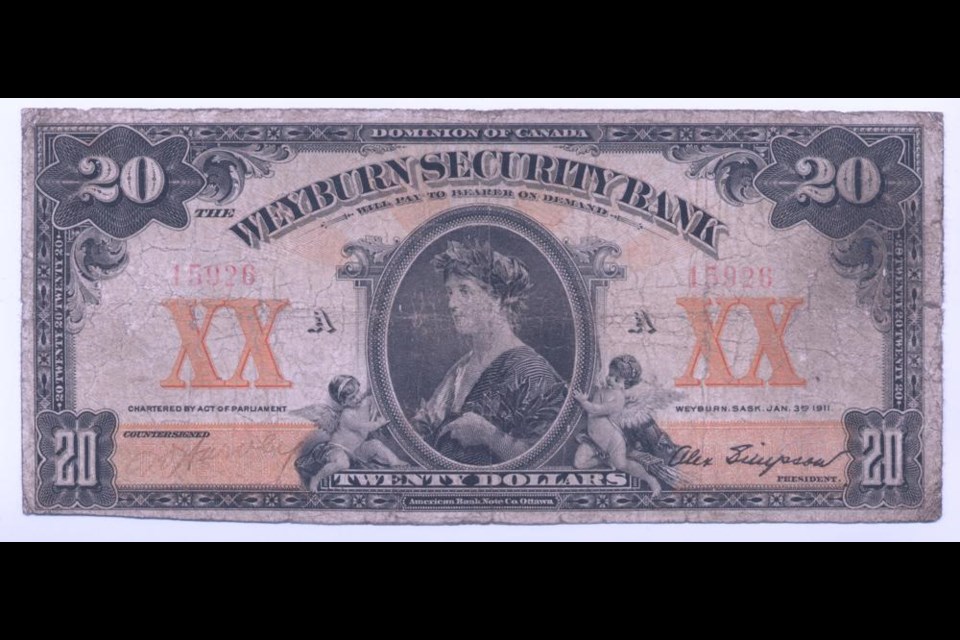WEYBURN – The Regina Coin Show will display four issued Weyburn Security Bank notes at its 2022 Spring Show and Sale. As well, five Proof Weyburn Security Bank notes will accompany the display.
The show takes place on April 23-24, at a new venue, The Italian Club, located at 2148 Connaught Street in Regina. Mayor Marcel Roy will open the show with some remarks
The Weyburn Security Bank notes are extremely rare, because the WSB officials cared about the appearance of the notes and then burned the vast majority of them. The Ninth Edition of Charlton Standard Catalogue Canadian Bank Notes lists only 50 notes known to exist with nine of them in institutional collections.
The face of the $5 note depicts a train in a city, while the $10 note portrays allegorical women and children. The $20 note has the portrait of a woman in an oval frame supported by two cherubs.
The Weyburn Security Company was formed in Weyburn in 1902 by a small group of American settlers from South Dakota and Minnesota. They purchased 50,000 acres of land with the aim to settle southeastern Saskatchewan.
In 1910, they petitioned the Canadian Parliament for a charter to incorporate as The Weyburn Security Bank, and on January 3, 1911, the Weyburn Security Bank opened for business with $1 million in capital and branches in nine southern Saskatchewan rural towns and villages. By 1924, the Weyburn Security Bank had branches in 27 different towns and villages as well as Weyburn. For more than 20 years, the small bank had to compete with much larger Canadian chartered banks.
Initially, the Weyburn Security Bank prospered by providing banking and other services to its mainly farming clientele. Unfortunately, the Great Depression resulted in three successive crop failures. So, the Weyburn Security Bank had discussions with the Imperial Bank of Canada, and in 1931, the Weyburn Security Bank ceased to exist after it merged with the Imperial Bank of Canada. The Imperial Bank of Canada continued until 1961, when it amalgamated with the Canadian Bank of Commerce to become the Canadian Imperial Bank of Commerce (CIBC).
In Cecil Tannahill’s ground-breaking book, “Saskatchewan Trade Tokens, Paper Money Scrip”, he detailed how the Weyburn Security Bank ended up issuing its own currency.
“When the Weyburn Security Company made application for the charter they also made application for the issuance of bank notes and the dating of the notes was timed to fit in with the commencement of business as a chartered bank. The order for the notes was placed with the American Bank Note Company, Ottawa, and notes dated January 3rd, 1911 were issued in denominations of $5, $10 and $20. The newly printed notes were shipped to the Head Office in Weyburn and were sent out to the various branches on requisition by the branch managers,” said Tannahill.
He noted the $5 and $10 notes would be shipped from head office in sheets of four and the $20 notes in sheets of two. The notes were to be cut by the manager of the receiving bank and he had to countersign the notes before they were placed in circulation.
“It was quite apparent that the officers of the Weyburn Security Bank wanted new notes available in each branch at all times and they appeared quite particular as to the condition of other notes being used. Their notes were very acceptable to the people of the region and it appears that 1925 was the peak year of circulation as records show $858,910 as notes outstanding.”
Tannahill wrote, “All soiled and mutilated notes when returned to head office were held until the next directors meeting, at which time three directors would count and burn the notes and the amount duly recorded.”





